University Healthcare Data Security and Data Masking Report
VerifiedAdded on 2023/05/29
|22
|6117
|459
Report
AI Summary
This report delves into the critical aspects of healthcare data security and data masking in the context of cloud computing. It begins with an introduction emphasizing the growing reliance on IT in healthcare and the subsequent need for robust data protection measures. The report outlines the problem statement, highlighting the sensitive nature of healthcare data and the increasing risks associated with data breaches. It explores the purpose of the study, which is to investigate technologies and methods for data masking and security, including HIPAA compliance and Health Information Exchange (HIE) Security Architecture. The study employs a mixed-method design, gathering feedback from healthcare industry developers. The report also addresses research questions concerning cloud security measures, healthcare data masking practices, and public opinion on technological changes. It reviews literature on cloud data safety, security measures provided by cloud computing companies, and the importance of data masking and encryption. Furthermore, it examines the characteristics of the research area and the problem, contributing to the literature by identifying gaps and proposing a conceptual framework for understanding the challenges and solutions in healthcare data security. Finally, the report defines key terms and concludes with a summary of the findings and recommendations.
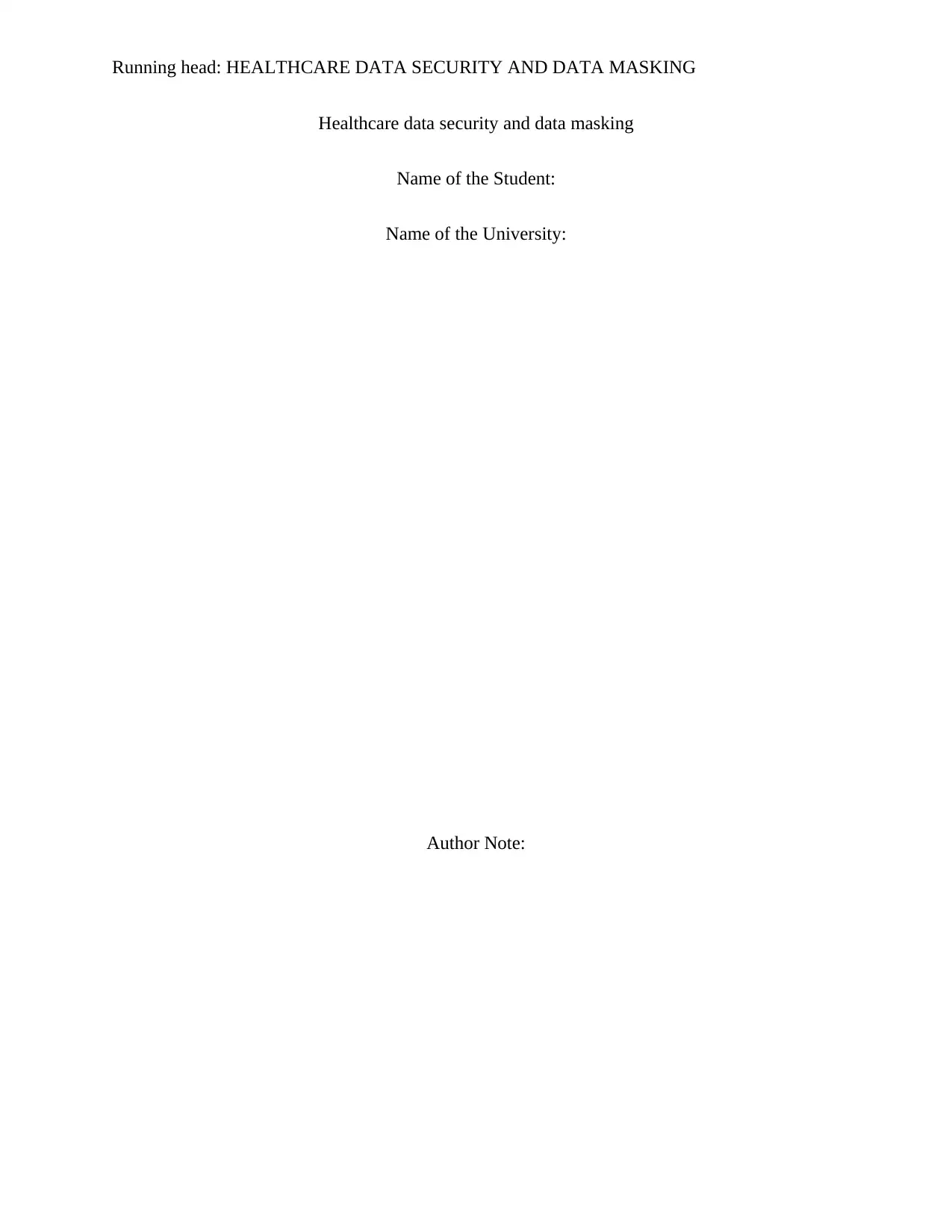
Running head: HEALTHCARE DATA SECURITY AND DATA MASKING
Healthcare data security and data masking
Name of the Student:
Name of the University:
Author Note:
Healthcare data security and data masking
Name of the Student:
Name of the University:
Author Note:
Paraphrase This Document
Need a fresh take? Get an instant paraphrase of this document with our AI Paraphraser
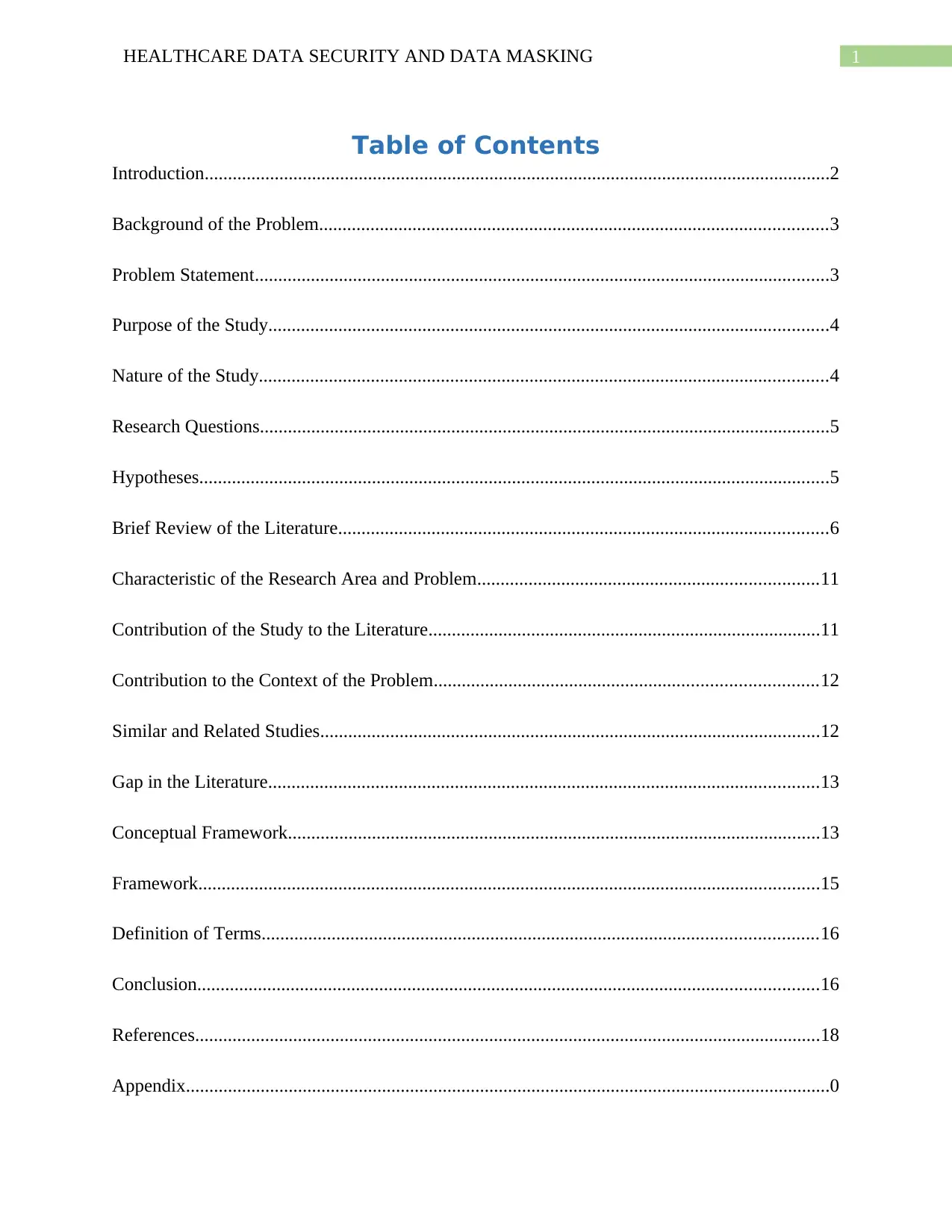
1HEALTHCARE DATA SECURITY AND DATA MASKING
Table of Contents
Introduction......................................................................................................................................2
Background of the Problem.............................................................................................................3
Problem Statement...........................................................................................................................3
Purpose of the Study........................................................................................................................4
Nature of the Study..........................................................................................................................4
Research Questions..........................................................................................................................5
Hypotheses.......................................................................................................................................5
Brief Review of the Literature.........................................................................................................6
Characteristic of the Research Area and Problem.........................................................................11
Contribution of the Study to the Literature....................................................................................11
Contribution to the Context of the Problem..................................................................................12
Similar and Related Studies...........................................................................................................12
Gap in the Literature......................................................................................................................13
Conceptual Framework..................................................................................................................13
Framework.....................................................................................................................................15
Definition of Terms.......................................................................................................................16
Conclusion.....................................................................................................................................16
References......................................................................................................................................18
Appendix..........................................................................................................................................0
Table of Contents
Introduction......................................................................................................................................2
Background of the Problem.............................................................................................................3
Problem Statement...........................................................................................................................3
Purpose of the Study........................................................................................................................4
Nature of the Study..........................................................................................................................4
Research Questions..........................................................................................................................5
Hypotheses.......................................................................................................................................5
Brief Review of the Literature.........................................................................................................6
Characteristic of the Research Area and Problem.........................................................................11
Contribution of the Study to the Literature....................................................................................11
Contribution to the Context of the Problem..................................................................................12
Similar and Related Studies...........................................................................................................12
Gap in the Literature......................................................................................................................13
Conceptual Framework..................................................................................................................13
Framework.....................................................................................................................................15
Definition of Terms.......................................................................................................................16
Conclusion.....................................................................................................................................16
References......................................................................................................................................18
Appendix..........................................................................................................................................0
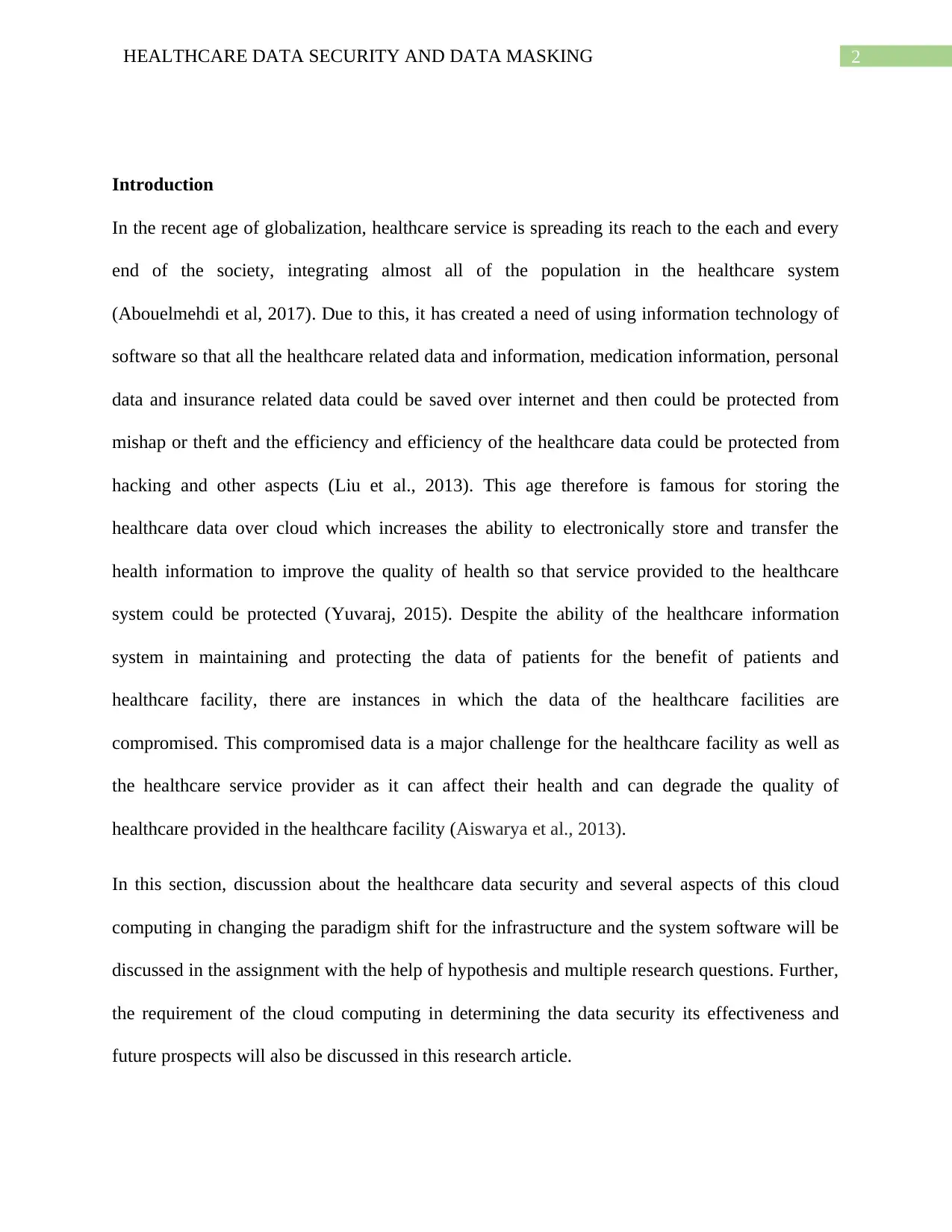
2HEALTHCARE DATA SECURITY AND DATA MASKING
Introduction
In the recent age of globalization, healthcare service is spreading its reach to the each and every
end of the society, integrating almost all of the population in the healthcare system
(Abouelmehdi et al, 2017). Due to this, it has created a need of using information technology of
software so that all the healthcare related data and information, medication information, personal
data and insurance related data could be saved over internet and then could be protected from
mishap or theft and the efficiency and efficiency of the healthcare data could be protected from
hacking and other aspects (Liu et al., 2013). This age therefore is famous for storing the
healthcare data over cloud which increases the ability to electronically store and transfer the
health information to improve the quality of health so that service provided to the healthcare
system could be protected (Yuvaraj, 2015). Despite the ability of the healthcare information
system in maintaining and protecting the data of patients for the benefit of patients and
healthcare facility, there are instances in which the data of the healthcare facilities are
compromised. This compromised data is a major challenge for the healthcare facility as well as
the healthcare service provider as it can affect their health and can degrade the quality of
healthcare provided in the healthcare facility (Aiswarya et al., 2013).
In this section, discussion about the healthcare data security and several aspects of this cloud
computing in changing the paradigm shift for the infrastructure and the system software will be
discussed in the assignment with the help of hypothesis and multiple research questions. Further,
the requirement of the cloud computing in determining the data security its effectiveness and
future prospects will also be discussed in this research article.
Introduction
In the recent age of globalization, healthcare service is spreading its reach to the each and every
end of the society, integrating almost all of the population in the healthcare system
(Abouelmehdi et al, 2017). Due to this, it has created a need of using information technology of
software so that all the healthcare related data and information, medication information, personal
data and insurance related data could be saved over internet and then could be protected from
mishap or theft and the efficiency and efficiency of the healthcare data could be protected from
hacking and other aspects (Liu et al., 2013). This age therefore is famous for storing the
healthcare data over cloud which increases the ability to electronically store and transfer the
health information to improve the quality of health so that service provided to the healthcare
system could be protected (Yuvaraj, 2015). Despite the ability of the healthcare information
system in maintaining and protecting the data of patients for the benefit of patients and
healthcare facility, there are instances in which the data of the healthcare facilities are
compromised. This compromised data is a major challenge for the healthcare facility as well as
the healthcare service provider as it can affect their health and can degrade the quality of
healthcare provided in the healthcare facility (Aiswarya et al., 2013).
In this section, discussion about the healthcare data security and several aspects of this cloud
computing in changing the paradigm shift for the infrastructure and the system software will be
discussed in the assignment with the help of hypothesis and multiple research questions. Further,
the requirement of the cloud computing in determining the data security its effectiveness and
future prospects will also be discussed in this research article.
⊘ This is a preview!⊘
Do you want full access?
Subscribe today to unlock all pages.

Trusted by 1+ million students worldwide
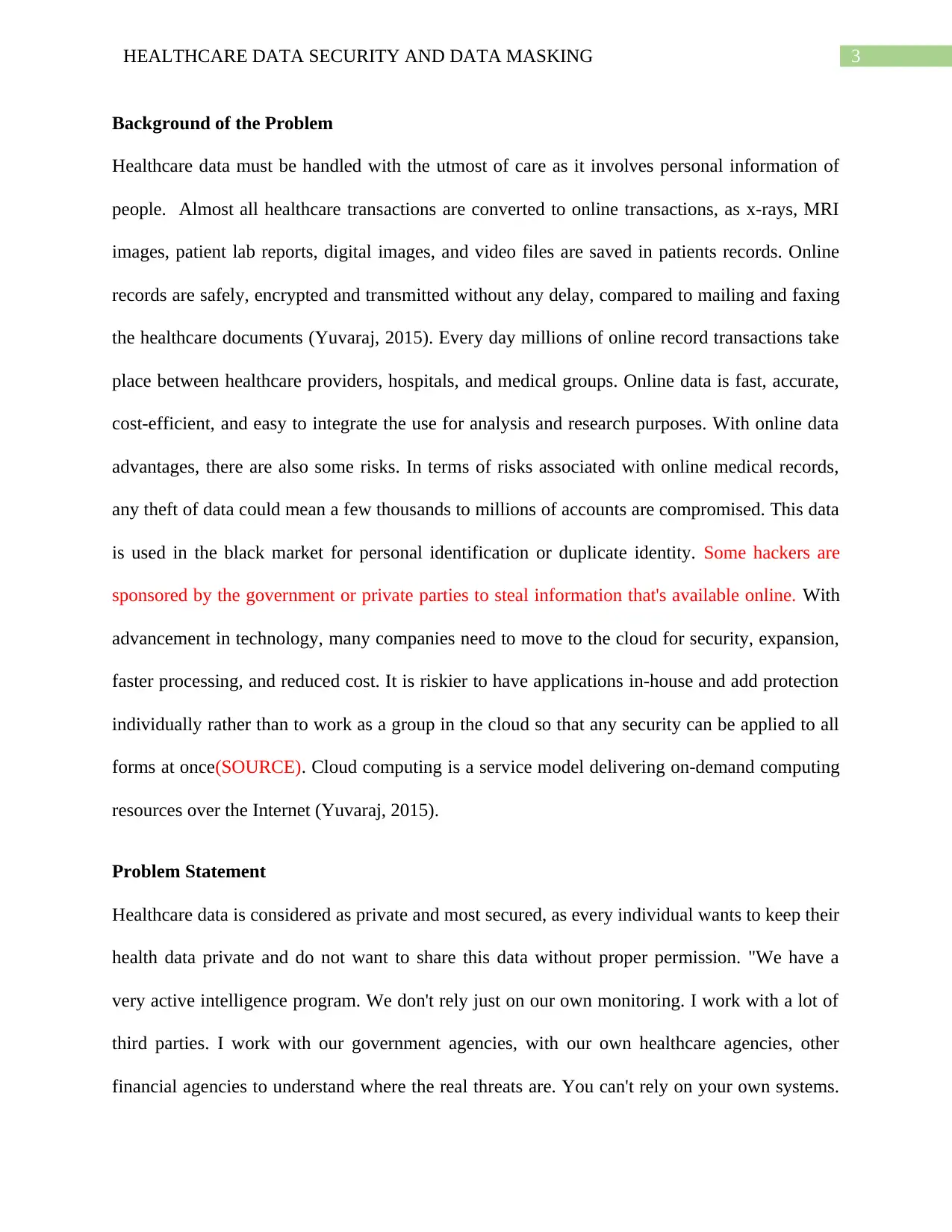
3HEALTHCARE DATA SECURITY AND DATA MASKING
Background of the Problem
Healthcare data must be handled with the utmost of care as it involves personal information of
people. Almost all healthcare transactions are converted to online transactions, as x-rays, MRI
images, patient lab reports, digital images, and video files are saved in patients records. Online
records are safely, encrypted and transmitted without any delay, compared to mailing and faxing
the healthcare documents (Yuvaraj, 2015). Every day millions of online record transactions take
place between healthcare providers, hospitals, and medical groups. Online data is fast, accurate,
cost-efficient, and easy to integrate the use for analysis and research purposes. With online data
advantages, there are also some risks. In terms of risks associated with online medical records,
any theft of data could mean a few thousands to millions of accounts are compromised. This data
is used in the black market for personal identification or duplicate identity. Some hackers are
sponsored by the government or private parties to steal information that's available online. With
advancement in technology, many companies need to move to the cloud for security, expansion,
faster processing, and reduced cost. It is riskier to have applications in-house and add protection
individually rather than to work as a group in the cloud so that any security can be applied to all
forms at once(SOURCE). Cloud computing is a service model delivering on-demand computing
resources over the Internet (Yuvaraj, 2015).
Problem Statement
Healthcare data is considered as private and most secured, as every individual wants to keep their
health data private and do not want to share this data without proper permission. "We have a
very active intelligence program. We don't rely just on our own monitoring. I work with a lot of
third parties. I work with our government agencies, with our own healthcare agencies, other
financial agencies to understand where the real threats are. You can't rely on your own systems.
Background of the Problem
Healthcare data must be handled with the utmost of care as it involves personal information of
people. Almost all healthcare transactions are converted to online transactions, as x-rays, MRI
images, patient lab reports, digital images, and video files are saved in patients records. Online
records are safely, encrypted and transmitted without any delay, compared to mailing and faxing
the healthcare documents (Yuvaraj, 2015). Every day millions of online record transactions take
place between healthcare providers, hospitals, and medical groups. Online data is fast, accurate,
cost-efficient, and easy to integrate the use for analysis and research purposes. With online data
advantages, there are also some risks. In terms of risks associated with online medical records,
any theft of data could mean a few thousands to millions of accounts are compromised. This data
is used in the black market for personal identification or duplicate identity. Some hackers are
sponsored by the government or private parties to steal information that's available online. With
advancement in technology, many companies need to move to the cloud for security, expansion,
faster processing, and reduced cost. It is riskier to have applications in-house and add protection
individually rather than to work as a group in the cloud so that any security can be applied to all
forms at once(SOURCE). Cloud computing is a service model delivering on-demand computing
resources over the Internet (Yuvaraj, 2015).
Problem Statement
Healthcare data is considered as private and most secured, as every individual wants to keep their
health data private and do not want to share this data without proper permission. "We have a
very active intelligence program. We don't rely just on our own monitoring. I work with a lot of
third parties. I work with our government agencies, with our own healthcare agencies, other
financial agencies to understand where the real threats are. You can't rely on your own systems.
Paraphrase This Document
Need a fresh take? Get an instant paraphrase of this document with our AI Paraphraser
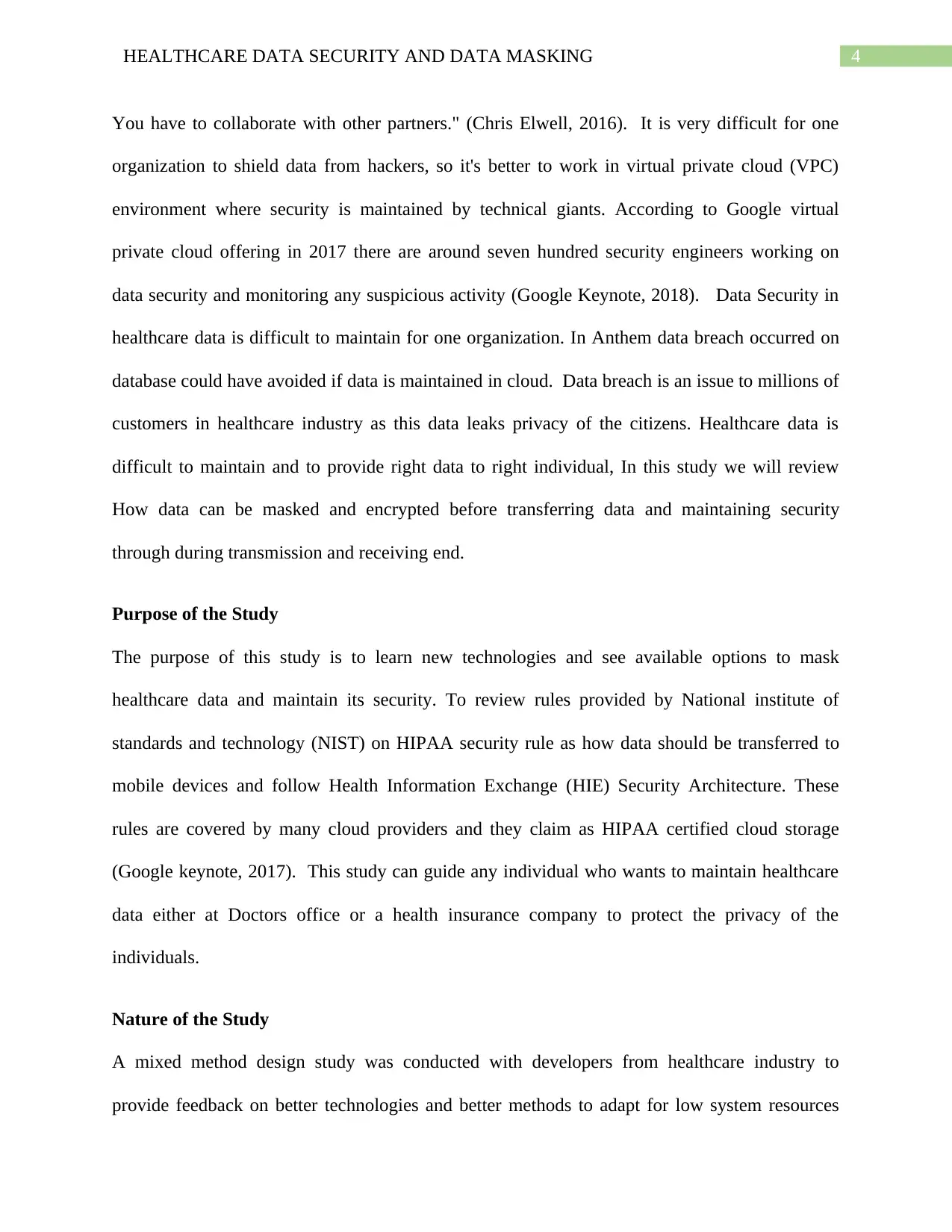
4HEALTHCARE DATA SECURITY AND DATA MASKING
You have to collaborate with other partners." (Chris Elwell, 2016). It is very difficult for one
organization to shield data from hackers, so it's better to work in virtual private cloud (VPC)
environment where security is maintained by technical giants. According to Google virtual
private cloud offering in 2017 there are around seven hundred security engineers working on
data security and monitoring any suspicious activity (Google Keynote, 2018). Data Security in
healthcare data is difficult to maintain for one organization. In Anthem data breach occurred on
database could have avoided if data is maintained in cloud. Data breach is an issue to millions of
customers in healthcare industry as this data leaks privacy of the citizens. Healthcare data is
difficult to maintain and to provide right data to right individual, In this study we will review
How data can be masked and encrypted before transferring data and maintaining security
through during transmission and receiving end.
Purpose of the Study
The purpose of this study is to learn new technologies and see available options to mask
healthcare data and maintain its security. To review rules provided by National institute of
standards and technology (NIST) on HIPAA security rule as how data should be transferred to
mobile devices and follow Health Information Exchange (HIE) Security Architecture. These
rules are covered by many cloud providers and they claim as HIPAA certified cloud storage
(Google keynote, 2017). This study can guide any individual who wants to maintain healthcare
data either at Doctors office or a health insurance company to protect the privacy of the
individuals.
Nature of the Study
A mixed method design study was conducted with developers from healthcare industry to
provide feedback on better technologies and better methods to adapt for low system resources
You have to collaborate with other partners." (Chris Elwell, 2016). It is very difficult for one
organization to shield data from hackers, so it's better to work in virtual private cloud (VPC)
environment where security is maintained by technical giants. According to Google virtual
private cloud offering in 2017 there are around seven hundred security engineers working on
data security and monitoring any suspicious activity (Google Keynote, 2018). Data Security in
healthcare data is difficult to maintain for one organization. In Anthem data breach occurred on
database could have avoided if data is maintained in cloud. Data breach is an issue to millions of
customers in healthcare industry as this data leaks privacy of the citizens. Healthcare data is
difficult to maintain and to provide right data to right individual, In this study we will review
How data can be masked and encrypted before transferring data and maintaining security
through during transmission and receiving end.
Purpose of the Study
The purpose of this study is to learn new technologies and see available options to mask
healthcare data and maintain its security. To review rules provided by National institute of
standards and technology (NIST) on HIPAA security rule as how data should be transferred to
mobile devices and follow Health Information Exchange (HIE) Security Architecture. These
rules are covered by many cloud providers and they claim as HIPAA certified cloud storage
(Google keynote, 2017). This study can guide any individual who wants to maintain healthcare
data either at Doctors office or a health insurance company to protect the privacy of the
individuals.
Nature of the Study
A mixed method design study was conducted with developers from healthcare industry to
provide feedback on better technologies and better methods to adapt for low system resources
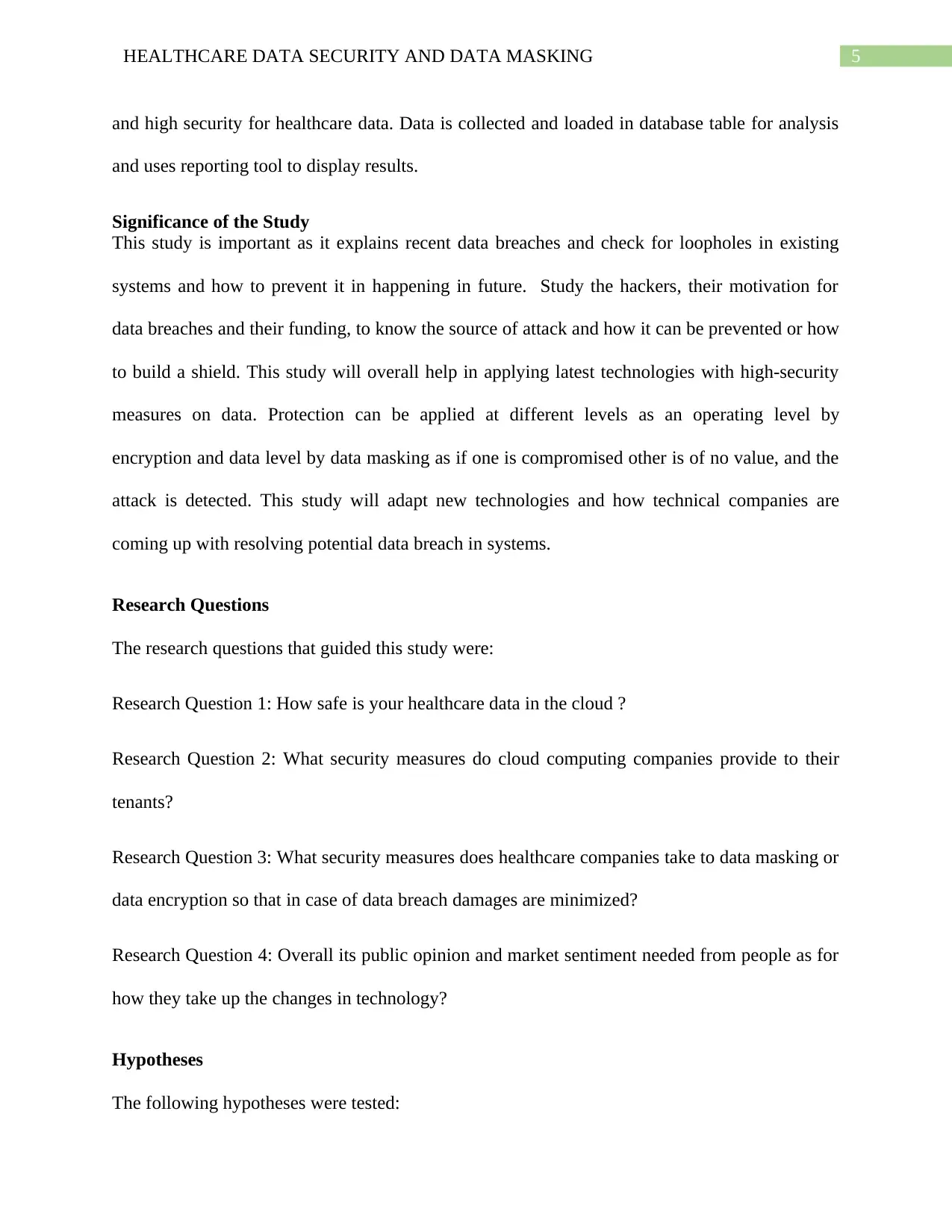
5HEALTHCARE DATA SECURITY AND DATA MASKING
and high security for healthcare data. Data is collected and loaded in database table for analysis
and uses reporting tool to display results.
Significance of the Study
This study is important as it explains recent data breaches and check for loopholes in existing
systems and how to prevent it in happening in future. Study the hackers, their motivation for
data breaches and their funding, to know the source of attack and how it can be prevented or how
to build a shield. This study will overall help in applying latest technologies with high-security
measures on data. Protection can be applied at different levels as an operating level by
encryption and data level by data masking as if one is compromised other is of no value, and the
attack is detected. This study will adapt new technologies and how technical companies are
coming up with resolving potential data breach in systems.
Research Questions
The research questions that guided this study were:
Research Question 1: How safe is your healthcare data in the cloud ?
Research Question 2: What security measures do cloud computing companies provide to their
tenants?
Research Question 3: What security measures does healthcare companies take to data masking or
data encryption so that in case of data breach damages are minimized?
Research Question 4: Overall its public opinion and market sentiment needed from people as for
how they take up the changes in technology?
Hypotheses
The following hypotheses were tested:
and high security for healthcare data. Data is collected and loaded in database table for analysis
and uses reporting tool to display results.
Significance of the Study
This study is important as it explains recent data breaches and check for loopholes in existing
systems and how to prevent it in happening in future. Study the hackers, their motivation for
data breaches and their funding, to know the source of attack and how it can be prevented or how
to build a shield. This study will overall help in applying latest technologies with high-security
measures on data. Protection can be applied at different levels as an operating level by
encryption and data level by data masking as if one is compromised other is of no value, and the
attack is detected. This study will adapt new technologies and how technical companies are
coming up with resolving potential data breach in systems.
Research Questions
The research questions that guided this study were:
Research Question 1: How safe is your healthcare data in the cloud ?
Research Question 2: What security measures do cloud computing companies provide to their
tenants?
Research Question 3: What security measures does healthcare companies take to data masking or
data encryption so that in case of data breach damages are minimized?
Research Question 4: Overall its public opinion and market sentiment needed from people as for
how they take up the changes in technology?
Hypotheses
The following hypotheses were tested:
⊘ This is a preview!⊘
Do you want full access?
Subscribe today to unlock all pages.

Trusted by 1+ million students worldwide
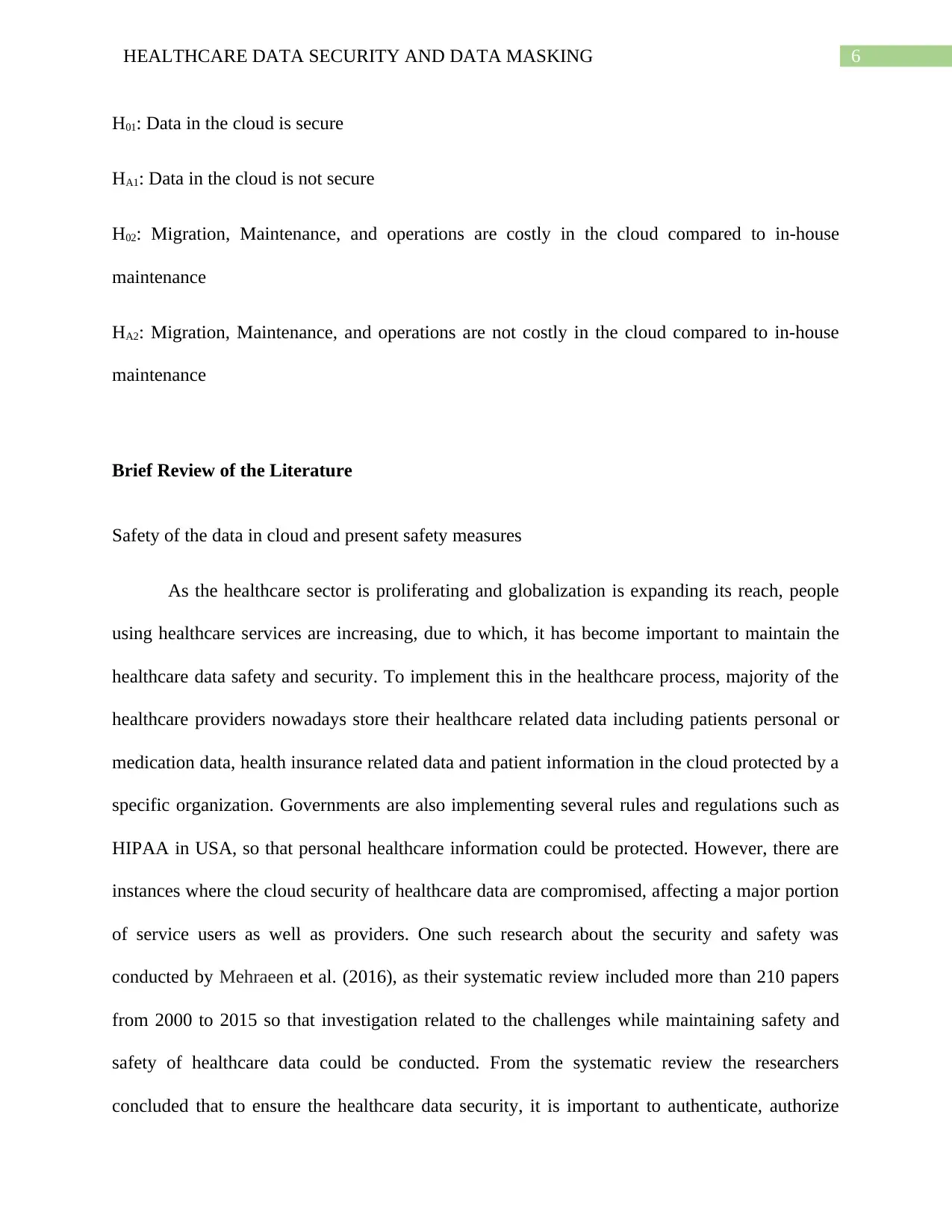
6HEALTHCARE DATA SECURITY AND DATA MASKING
H01: Data in the cloud is secure
HA1: Data in the cloud is not secure
H02: Migration, Maintenance, and operations are costly in the cloud compared to in-house
maintenance
HA2: Migration, Maintenance, and operations are not costly in the cloud compared to in-house
maintenance
Brief Review of the Literature
Safety of the data in cloud and present safety measures
As the healthcare sector is proliferating and globalization is expanding its reach, people
using healthcare services are increasing, due to which, it has become important to maintain the
healthcare data safety and security. To implement this in the healthcare process, majority of the
healthcare providers nowadays store their healthcare related data including patients personal or
medication data, health insurance related data and patient information in the cloud protected by a
specific organization. Governments are also implementing several rules and regulations such as
HIPAA in USA, so that personal healthcare information could be protected. However, there are
instances where the cloud security of healthcare data are compromised, affecting a major portion
of service users as well as providers. One such research about the security and safety was
conducted by Mehraeen et al. (2016), as their systematic review included more than 210 papers
from 2000 to 2015 so that investigation related to the challenges while maintaining safety and
safety of healthcare data could be conducted. From the systematic review the researchers
concluded that to ensure the healthcare data security, it is important to authenticate, authorize
H01: Data in the cloud is secure
HA1: Data in the cloud is not secure
H02: Migration, Maintenance, and operations are costly in the cloud compared to in-house
maintenance
HA2: Migration, Maintenance, and operations are not costly in the cloud compared to in-house
maintenance
Brief Review of the Literature
Safety of the data in cloud and present safety measures
As the healthcare sector is proliferating and globalization is expanding its reach, people
using healthcare services are increasing, due to which, it has become important to maintain the
healthcare data safety and security. To implement this in the healthcare process, majority of the
healthcare providers nowadays store their healthcare related data including patients personal or
medication data, health insurance related data and patient information in the cloud protected by a
specific organization. Governments are also implementing several rules and regulations such as
HIPAA in USA, so that personal healthcare information could be protected. However, there are
instances where the cloud security of healthcare data are compromised, affecting a major portion
of service users as well as providers. One such research about the security and safety was
conducted by Mehraeen et al. (2016), as their systematic review included more than 210 papers
from 2000 to 2015 so that investigation related to the challenges while maintaining safety and
safety of healthcare data could be conducted. From the systematic review the researchers
concluded that to ensure the healthcare data security, it is important to authenticate, authorize
Paraphrase This Document
Need a fresh take? Get an instant paraphrase of this document with our AI Paraphraser
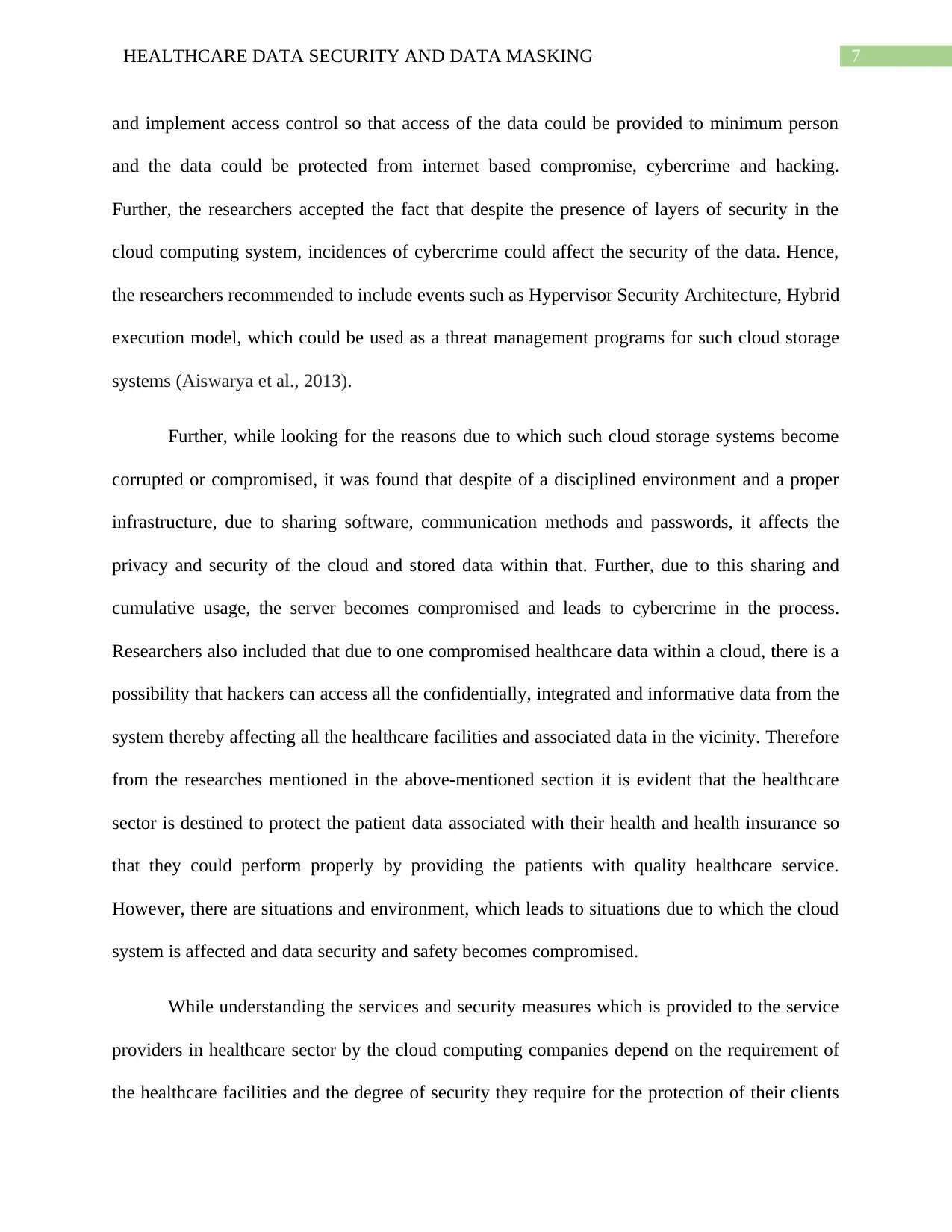
7HEALTHCARE DATA SECURITY AND DATA MASKING
and implement access control so that access of the data could be provided to minimum person
and the data could be protected from internet based compromise, cybercrime and hacking.
Further, the researchers accepted the fact that despite the presence of layers of security in the
cloud computing system, incidences of cybercrime could affect the security of the data. Hence,
the researchers recommended to include events such as Hypervisor Security Architecture, Hybrid
execution model, which could be used as a threat management programs for such cloud storage
systems (Aiswarya et al., 2013).
Further, while looking for the reasons due to which such cloud storage systems become
corrupted or compromised, it was found that despite of a disciplined environment and a proper
infrastructure, due to sharing software, communication methods and passwords, it affects the
privacy and security of the cloud and stored data within that. Further, due to this sharing and
cumulative usage, the server becomes compromised and leads to cybercrime in the process.
Researchers also included that due to one compromised healthcare data within a cloud, there is a
possibility that hackers can access all the confidentially, integrated and informative data from the
system thereby affecting all the healthcare facilities and associated data in the vicinity. Therefore
from the researches mentioned in the above-mentioned section it is evident that the healthcare
sector is destined to protect the patient data associated with their health and health insurance so
that they could perform properly by providing the patients with quality healthcare service.
However, there are situations and environment, which leads to situations due to which the cloud
system is affected and data security and safety becomes compromised.
While understanding the services and security measures which is provided to the service
providers in healthcare sector by the cloud computing companies depend on the requirement of
the healthcare facilities and the degree of security they require for the protection of their clients
and implement access control so that access of the data could be provided to minimum person
and the data could be protected from internet based compromise, cybercrime and hacking.
Further, the researchers accepted the fact that despite the presence of layers of security in the
cloud computing system, incidences of cybercrime could affect the security of the data. Hence,
the researchers recommended to include events such as Hypervisor Security Architecture, Hybrid
execution model, which could be used as a threat management programs for such cloud storage
systems (Aiswarya et al., 2013).
Further, while looking for the reasons due to which such cloud storage systems become
corrupted or compromised, it was found that despite of a disciplined environment and a proper
infrastructure, due to sharing software, communication methods and passwords, it affects the
privacy and security of the cloud and stored data within that. Further, due to this sharing and
cumulative usage, the server becomes compromised and leads to cybercrime in the process.
Researchers also included that due to one compromised healthcare data within a cloud, there is a
possibility that hackers can access all the confidentially, integrated and informative data from the
system thereby affecting all the healthcare facilities and associated data in the vicinity. Therefore
from the researches mentioned in the above-mentioned section it is evident that the healthcare
sector is destined to protect the patient data associated with their health and health insurance so
that they could perform properly by providing the patients with quality healthcare service.
However, there are situations and environment, which leads to situations due to which the cloud
system is affected and data security and safety becomes compromised.
While understanding the services and security measures which is provided to the service
providers in healthcare sector by the cloud computing companies depend on the requirement of
the healthcare facilities and the degree of security they require for the protection of their clients
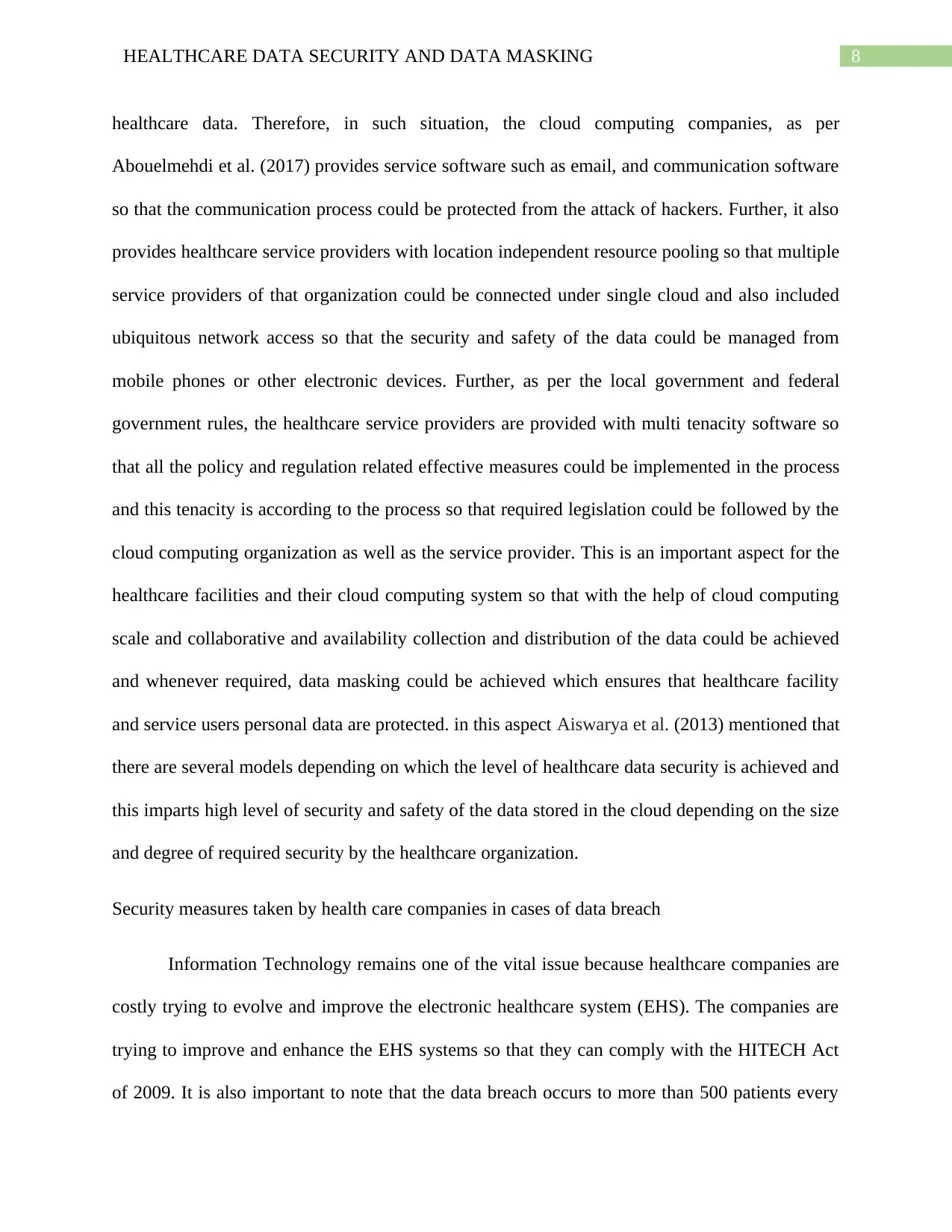
8HEALTHCARE DATA SECURITY AND DATA MASKING
healthcare data. Therefore, in such situation, the cloud computing companies, as per
Abouelmehdi et al. (2017) provides service software such as email, and communication software
so that the communication process could be protected from the attack of hackers. Further, it also
provides healthcare service providers with location independent resource pooling so that multiple
service providers of that organization could be connected under single cloud and also included
ubiquitous network access so that the security and safety of the data could be managed from
mobile phones or other electronic devices. Further, as per the local government and federal
government rules, the healthcare service providers are provided with multi tenacity software so
that all the policy and regulation related effective measures could be implemented in the process
and this tenacity is according to the process so that required legislation could be followed by the
cloud computing organization as well as the service provider. This is an important aspect for the
healthcare facilities and their cloud computing system so that with the help of cloud computing
scale and collaborative and availability collection and distribution of the data could be achieved
and whenever required, data masking could be achieved which ensures that healthcare facility
and service users personal data are protected. in this aspect Aiswarya et al. (2013) mentioned that
there are several models depending on which the level of healthcare data security is achieved and
this imparts high level of security and safety of the data stored in the cloud depending on the size
and degree of required security by the healthcare organization.
Security measures taken by health care companies in cases of data breach
Information Technology remains one of the vital issue because healthcare companies are
costly trying to evolve and improve the electronic healthcare system (EHS). The companies are
trying to improve and enhance the EHS systems so that they can comply with the HITECH Act
of 2009. It is also important to note that the data breach occurs to more than 500 patients every
healthcare data. Therefore, in such situation, the cloud computing companies, as per
Abouelmehdi et al. (2017) provides service software such as email, and communication software
so that the communication process could be protected from the attack of hackers. Further, it also
provides healthcare service providers with location independent resource pooling so that multiple
service providers of that organization could be connected under single cloud and also included
ubiquitous network access so that the security and safety of the data could be managed from
mobile phones or other electronic devices. Further, as per the local government and federal
government rules, the healthcare service providers are provided with multi tenacity software so
that all the policy and regulation related effective measures could be implemented in the process
and this tenacity is according to the process so that required legislation could be followed by the
cloud computing organization as well as the service provider. This is an important aspect for the
healthcare facilities and their cloud computing system so that with the help of cloud computing
scale and collaborative and availability collection and distribution of the data could be achieved
and whenever required, data masking could be achieved which ensures that healthcare facility
and service users personal data are protected. in this aspect Aiswarya et al. (2013) mentioned that
there are several models depending on which the level of healthcare data security is achieved and
this imparts high level of security and safety of the data stored in the cloud depending on the size
and degree of required security by the healthcare organization.
Security measures taken by health care companies in cases of data breach
Information Technology remains one of the vital issue because healthcare companies are
costly trying to evolve and improve the electronic healthcare system (EHS). The companies are
trying to improve and enhance the EHS systems so that they can comply with the HITECH Act
of 2009. It is also important to note that the data breach occurs to more than 500 patients every
⊘ This is a preview!⊘
Do you want full access?
Subscribe today to unlock all pages.

Trusted by 1+ million students worldwide
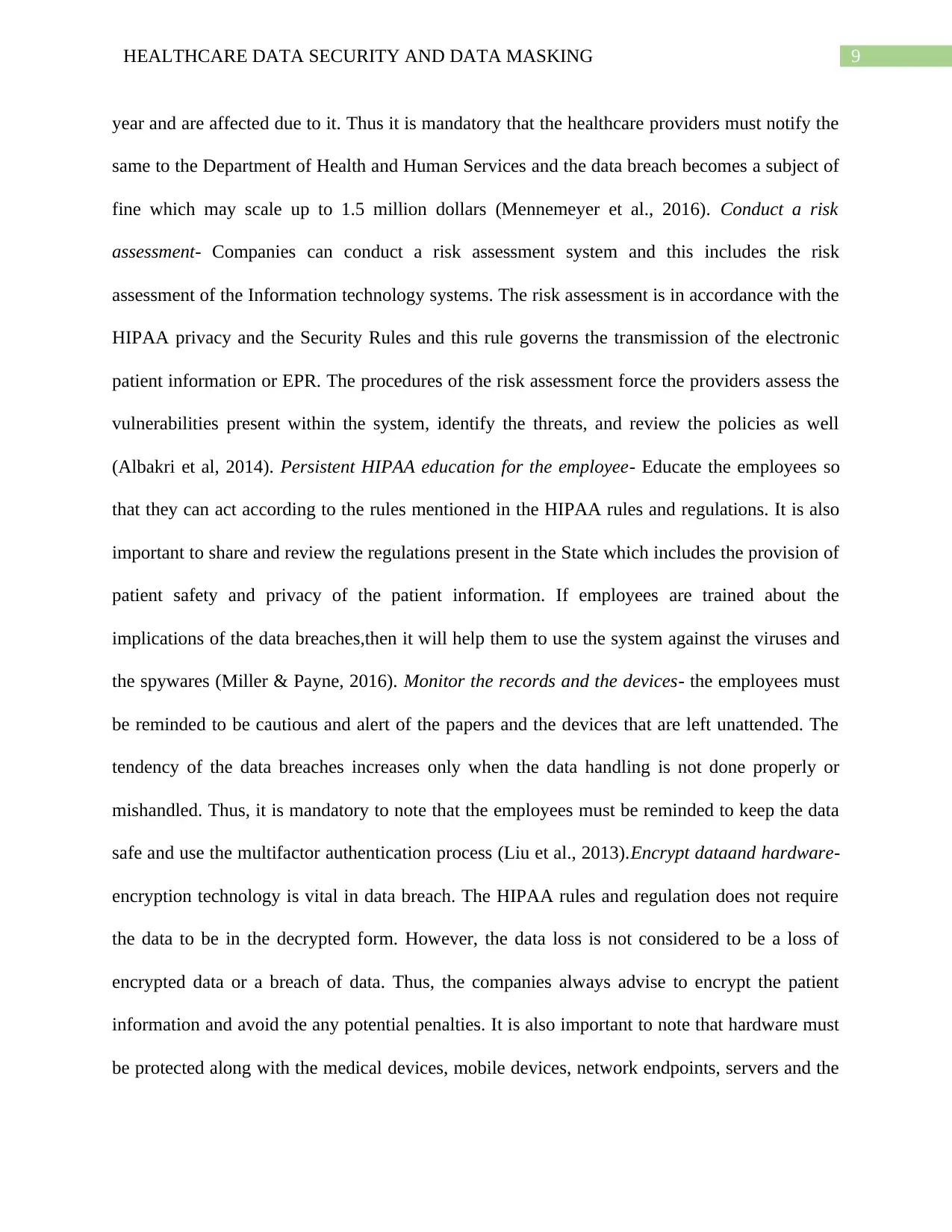
9HEALTHCARE DATA SECURITY AND DATA MASKING
year and are affected due to it. Thus it is mandatory that the healthcare providers must notify the
same to the Department of Health and Human Services and the data breach becomes a subject of
fine which may scale up to 1.5 million dollars (Mennemeyer et al., 2016). Conduct a risk
assessment- Companies can conduct a risk assessment system and this includes the risk
assessment of the Information technology systems. The risk assessment is in accordance with the
HIPAA privacy and the Security Rules and this rule governs the transmission of the electronic
patient information or EPR. The procedures of the risk assessment force the providers assess the
vulnerabilities present within the system, identify the threats, and review the policies as well
(Albakri et al, 2014). Persistent HIPAA education for the employee- Educate the employees so
that they can act according to the rules mentioned in the HIPAA rules and regulations. It is also
important to share and review the regulations present in the State which includes the provision of
patient safety and privacy of the patient information. If employees are trained about the
implications of the data breaches,then it will help them to use the system against the viruses and
the spywares (Miller & Payne, 2016). Monitor the records and the devices- the employees must
be reminded to be cautious and alert of the papers and the devices that are left unattended. The
tendency of the data breaches increases only when the data handling is not done properly or
mishandled. Thus, it is mandatory to note that the employees must be reminded to keep the data
safe and use the multifactor authentication process (Liu et al., 2013).Encrypt dataand hardware-
encryption technology is vital in data breach. The HIPAA rules and regulation does not require
the data to be in the decrypted form. However, the data loss is not considered to be a loss of
encrypted data or a breach of data. Thus, the companies always advise to encrypt the patient
information and avoid the any potential penalties. It is also important to note that hardware must
be protected along with the medical devices, mobile devices, network endpoints, servers and the
year and are affected due to it. Thus it is mandatory that the healthcare providers must notify the
same to the Department of Health and Human Services and the data breach becomes a subject of
fine which may scale up to 1.5 million dollars (Mennemeyer et al., 2016). Conduct a risk
assessment- Companies can conduct a risk assessment system and this includes the risk
assessment of the Information technology systems. The risk assessment is in accordance with the
HIPAA privacy and the Security Rules and this rule governs the transmission of the electronic
patient information or EPR. The procedures of the risk assessment force the providers assess the
vulnerabilities present within the system, identify the threats, and review the policies as well
(Albakri et al, 2014). Persistent HIPAA education for the employee- Educate the employees so
that they can act according to the rules mentioned in the HIPAA rules and regulations. It is also
important to share and review the regulations present in the State which includes the provision of
patient safety and privacy of the patient information. If employees are trained about the
implications of the data breaches,then it will help them to use the system against the viruses and
the spywares (Miller & Payne, 2016). Monitor the records and the devices- the employees must
be reminded to be cautious and alert of the papers and the devices that are left unattended. The
tendency of the data breaches increases only when the data handling is not done properly or
mishandled. Thus, it is mandatory to note that the employees must be reminded to keep the data
safe and use the multifactor authentication process (Liu et al., 2013).Encrypt dataand hardware-
encryption technology is vital in data breach. The HIPAA rules and regulation does not require
the data to be in the decrypted form. However, the data loss is not considered to be a loss of
encrypted data or a breach of data. Thus, the companies always advise to encrypt the patient
information and avoid the any potential penalties. It is also important to note that hardware must
be protected along with the medical devices, mobile devices, network endpoints, servers and the
Paraphrase This Document
Need a fresh take? Get an instant paraphrase of this document with our AI Paraphraser
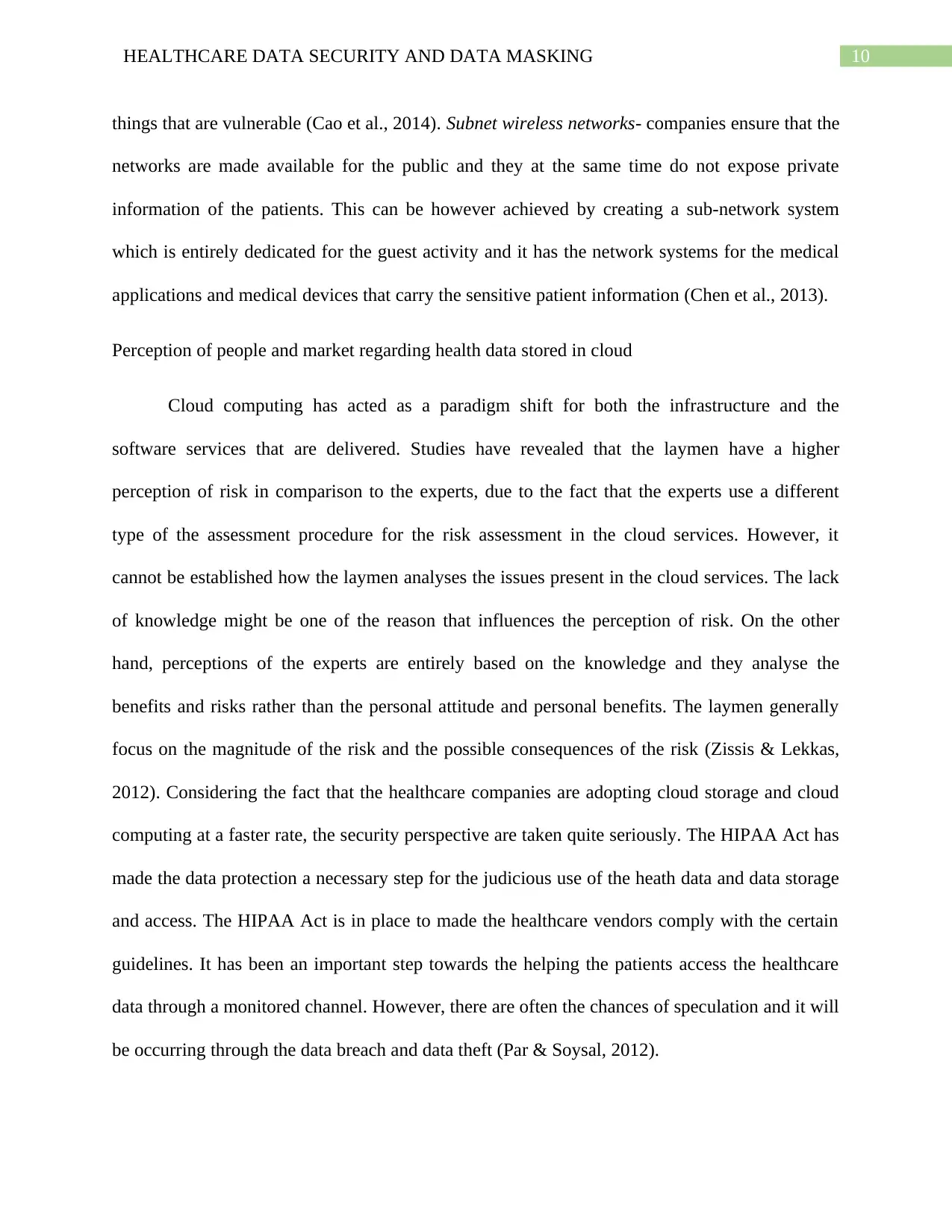
10HEALTHCARE DATA SECURITY AND DATA MASKING
things that are vulnerable (Cao et al., 2014). Subnet wireless networks- companies ensure that the
networks are made available for the public and they at the same time do not expose private
information of the patients. This can be however achieved by creating a sub-network system
which is entirely dedicated for the guest activity and it has the network systems for the medical
applications and medical devices that carry the sensitive patient information (Chen et al., 2013).
Perception of people and market regarding health data stored in cloud
Cloud computing has acted as a paradigm shift for both the infrastructure and the
software services that are delivered. Studies have revealed that the laymen have a higher
perception of risk in comparison to the experts, due to the fact that the experts use a different
type of the assessment procedure for the risk assessment in the cloud services. However, it
cannot be established how the laymen analyses the issues present in the cloud services. The lack
of knowledge might be one of the reason that influences the perception of risk. On the other
hand, perceptions of the experts are entirely based on the knowledge and they analyse the
benefits and risks rather than the personal attitude and personal benefits. The laymen generally
focus on the magnitude of the risk and the possible consequences of the risk (Zissis & Lekkas,
2012). Considering the fact that the healthcare companies are adopting cloud storage and cloud
computing at a faster rate, the security perspective are taken quite seriously. The HIPAA Act has
made the data protection a necessary step for the judicious use of the heath data and data storage
and access. The HIPAA Act is in place to made the healthcare vendors comply with the certain
guidelines. It has been an important step towards the helping the patients access the healthcare
data through a monitored channel. However, there are often the chances of speculation and it will
be occurring through the data breach and data theft (Par & Soysal, 2012).
things that are vulnerable (Cao et al., 2014). Subnet wireless networks- companies ensure that the
networks are made available for the public and they at the same time do not expose private
information of the patients. This can be however achieved by creating a sub-network system
which is entirely dedicated for the guest activity and it has the network systems for the medical
applications and medical devices that carry the sensitive patient information (Chen et al., 2013).
Perception of people and market regarding health data stored in cloud
Cloud computing has acted as a paradigm shift for both the infrastructure and the
software services that are delivered. Studies have revealed that the laymen have a higher
perception of risk in comparison to the experts, due to the fact that the experts use a different
type of the assessment procedure for the risk assessment in the cloud services. However, it
cannot be established how the laymen analyses the issues present in the cloud services. The lack
of knowledge might be one of the reason that influences the perception of risk. On the other
hand, perceptions of the experts are entirely based on the knowledge and they analyse the
benefits and risks rather than the personal attitude and personal benefits. The laymen generally
focus on the magnitude of the risk and the possible consequences of the risk (Zissis & Lekkas,
2012). Considering the fact that the healthcare companies are adopting cloud storage and cloud
computing at a faster rate, the security perspective are taken quite seriously. The HIPAA Act has
made the data protection a necessary step for the judicious use of the heath data and data storage
and access. The HIPAA Act is in place to made the healthcare vendors comply with the certain
guidelines. It has been an important step towards the helping the patients access the healthcare
data through a monitored channel. However, there are often the chances of speculation and it will
be occurring through the data breach and data theft (Par & Soysal, 2012).
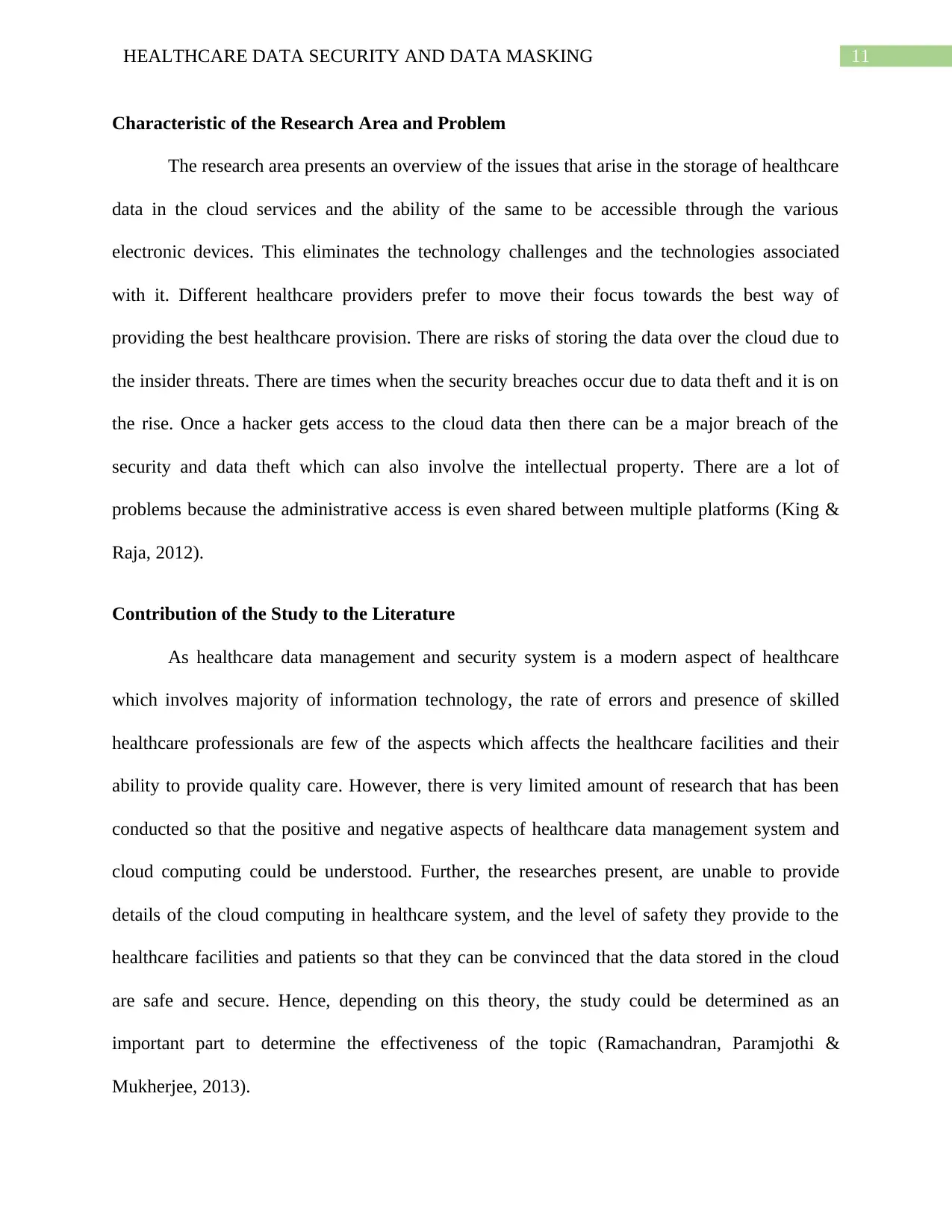
11HEALTHCARE DATA SECURITY AND DATA MASKING
Characteristic of the Research Area and Problem
The research area presents an overview of the issues that arise in the storage of healthcare
data in the cloud services and the ability of the same to be accessible through the various
electronic devices. This eliminates the technology challenges and the technologies associated
with it. Different healthcare providers prefer to move their focus towards the best way of
providing the best healthcare provision. There are risks of storing the data over the cloud due to
the insider threats. There are times when the security breaches occur due to data theft and it is on
the rise. Once a hacker gets access to the cloud data then there can be a major breach of the
security and data theft which can also involve the intellectual property. There are a lot of
problems because the administrative access is even shared between multiple platforms (King &
Raja, 2012).
Contribution of the Study to the Literature
As healthcare data management and security system is a modern aspect of healthcare
which involves majority of information technology, the rate of errors and presence of skilled
healthcare professionals are few of the aspects which affects the healthcare facilities and their
ability to provide quality care. However, there is very limited amount of research that has been
conducted so that the positive and negative aspects of healthcare data management system and
cloud computing could be understood. Further, the researches present, are unable to provide
details of the cloud computing in healthcare system, and the level of safety they provide to the
healthcare facilities and patients so that they can be convinced that the data stored in the cloud
are safe and secure. Hence, depending on this theory, the study could be determined as an
important part to determine the effectiveness of the topic (Ramachandran, Paramjothi &
Mukherjee, 2013).
Characteristic of the Research Area and Problem
The research area presents an overview of the issues that arise in the storage of healthcare
data in the cloud services and the ability of the same to be accessible through the various
electronic devices. This eliminates the technology challenges and the technologies associated
with it. Different healthcare providers prefer to move their focus towards the best way of
providing the best healthcare provision. There are risks of storing the data over the cloud due to
the insider threats. There are times when the security breaches occur due to data theft and it is on
the rise. Once a hacker gets access to the cloud data then there can be a major breach of the
security and data theft which can also involve the intellectual property. There are a lot of
problems because the administrative access is even shared between multiple platforms (King &
Raja, 2012).
Contribution of the Study to the Literature
As healthcare data management and security system is a modern aspect of healthcare
which involves majority of information technology, the rate of errors and presence of skilled
healthcare professionals are few of the aspects which affects the healthcare facilities and their
ability to provide quality care. However, there is very limited amount of research that has been
conducted so that the positive and negative aspects of healthcare data management system and
cloud computing could be understood. Further, the researches present, are unable to provide
details of the cloud computing in healthcare system, and the level of safety they provide to the
healthcare facilities and patients so that they can be convinced that the data stored in the cloud
are safe and secure. Hence, depending on this theory, the study could be determined as an
important part to determine the effectiveness of the topic (Ramachandran, Paramjothi &
Mukherjee, 2013).
⊘ This is a preview!⊘
Do you want full access?
Subscribe today to unlock all pages.

Trusted by 1+ million students worldwide
1 out of 22
Related Documents
Your All-in-One AI-Powered Toolkit for Academic Success.
+13062052269
info@desklib.com
Available 24*7 on WhatsApp / Email
![[object Object]](/_next/static/media/star-bottom.7253800d.svg)
Unlock your academic potential
Copyright © 2020–2025 A2Z Services. All Rights Reserved. Developed and managed by ZUCOL.





